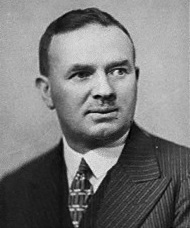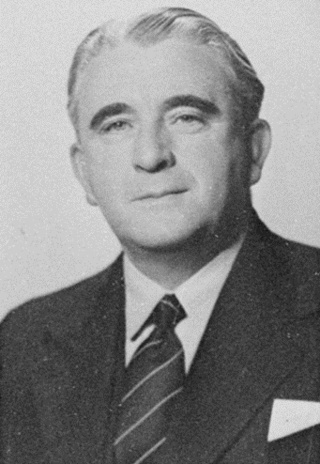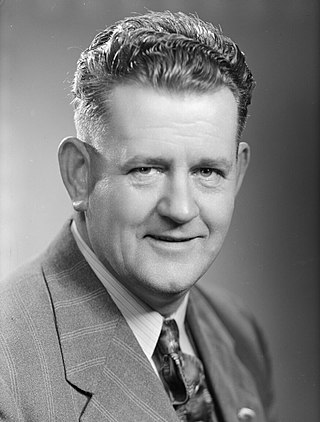| ||||||||||||||||
| Turnout | 7,466 | |||||||||||||||
|---|---|---|---|---|---|---|---|---|---|---|---|---|---|---|---|---|
| ||||||||||||||||
| ||||||||||||||||
The 1944 Awarua by-election was a by-election held during the 27th New Zealand Parliament in the Southland electorate of Awarua. The by-election occurred following the death of MP James Hargest and was won by George Herron.
| ||||||||||||||||
| Turnout | 7,466 | |||||||||||||||
|---|---|---|---|---|---|---|---|---|---|---|---|---|---|---|---|---|
| ||||||||||||||||
| ||||||||||||||||
The 1944 Awarua by-election was a by-election held during the 27th New Zealand Parliament in the Southland electorate of Awarua. The by-election occurred following the death of MP James Hargest and was won by George Herron.
Hargest, who was first elected to represent Awarua in 1935, was killed in action on 12 August 1944. His death instigated the Awarua by-election, which was contested by three candidates.
George Herron, a local official in the Farmers Union, was chosen to contest the seat for the National Party. The Labour Party chose local schoolteacher Leo Sylvester O'Sullivan as their nominee. Previously, Labour had attempted to secure Victoria Cross recipient Jack Hinton to stand as their candidate, who had previously signalled his interest in pursuing a career in politics, however he was unable to be contacted to confirm his candidacy. [1] Robert Henderson, a local pensioner, stood for the Real Democracy Movement who advocated for monetary reform.
The following table gives the election results:
| Party | Candidate | Votes | % | ±% | |
|---|---|---|---|---|---|
| National | George Herron | 4,659 | 62.40 | ||
| Labour | Leo Sylvester O'Sullivan | 2,558 | 34.26 | ||
| Real Democracy | Robert Henderson | 249 | 3.33 | ||
| Majority | 2,101 | 28.14 | |||
| Turnout | 7,466 | ||||

The 1975 New Zealand general election was held on 29 November to elect MPs to the 38th session of the New Zealand Parliament. It was the first general election in New Zealand where 18- to 20-year-olds and all permanent residents of New Zealand were eligible to vote, although only citizens were able to be elected.

The 1935 New Zealand general election was a nationwide vote to determine the shape of the New Zealand Parliament's 25th term. It resulted in the Labour Party's first electoral victory, with Michael Joseph Savage becoming the first Labour Prime Minister after defeating the governing coalition, consisting of the United Party and the Reform Party, in a landslide.

The 1938 New Zealand general election was a nationwide vote to determine the shape of the New Zealand Parliament's 26th term. It resulted in the governing Labour Party being re-elected in a landslide, winning nearly 56% of the vote despite not gaining any more seats. Having replaced the United-Reform coalition, the newly founded National Party also gained a certain amount of ground.

The 1943 New Zealand general election was a nationwide vote to determine the shape of the New Zealand Parliament's 27th term. With the onset of World War II, elections were initially postponed, but it was eventually decided to hold a general election in September 1943, around two years after it would normally have occurred. The election saw the governing Labour Party re-elected by a comfortable margin, although the party nevertheless lost considerable ground to the expanding National Party.

The 25th New Zealand Parliament was a term of the New Zealand Parliament. It opened on 25 March 1936, following the 1935 election. It was dissolved on 16 September 1938 in preparation for the 1938 election.

Adam Hamilton was a New Zealand politician. He was the first non-interim Leader of the National Party during its early years in Opposition.

The 1925 New Zealand general election was held 4 November to elect a total of 80 MPs to the 22nd session of the New Zealand Parliament.

Brigadier James Hargest, was an officer of the New Zealand Military Forces, serving in both the First and Second World Wars. He was a Member of New Zealand's Parliament from 1931 to 1944, representing firstly the Invercargill and then the Awarua electorates.

Invercargill is an electorate of the New Zealand Parliament that has existed since 1866. Since the 2020 election, the electorate's representative is Penny Simmonds of the National Party.

Neville George Pickering was a New Zealand politician of the Labour Party.
Awarua was a New Zealand parliamentary electorate from 1881 to 1996.
George Richard Herron (1888–1967) was a New Zealand politician of the National Party.

The 22nd New Zealand Parliament was a term of the New Zealand Parliament. Its composition was determined by the 1925 election, and it sat until the 1928 election.

Thomas Francis Doyle (1893–1968) was a member of the New Zealand Legislative Council from 1936 to 1950.

The 1930 Invercargill by-election was a by-election during the 23rd New Zealand Parliament in the Southland electorate of Invercargill. The by-election occurred following the death of Sir Joseph Ward on 8 July 1930. The by-election, which was held on 13 August, was won by the late Prime Minister's second son, Vincent Ward against James Hargest.

The Northern Maori by-election of 1963 was a by-election for the electorate of Northern Maori on 16 March 1963 during the 33rd New Zealand Parliament. The by-election resulted from the death of the previous member Tapihana Paikea on 7 January 1963. It was held the same day as the Otahuhu by-election.
The Grey Lynn by-election 1963 was a by-election held in the Grey Lynn electorate in Auckland during the term of the 33rd New Zealand Parliament, on 18 May 1963.

The Onehunga by-election 1953 was a by-election held in the Onehunga electorate in Auckland during the term of the 30th New Zealand Parliament, on 19 December 1953. The by-election was won by Hugh Watt of the Labour Party.

The Raglan by-election of 1927 was a by-election held in the Raglan electorate during the 22nd New Zealand Parliament, on 29 September 1927. It was caused by the death of incumbent MP Richard Bollard of the Reform Party. Despite being a local contest it quickly became a national contest in miniature due to growing discontent with the Reform Government.

The 1945 Hamilton by-election was a by-election held during the 27th New Zealand Parliament in the Waikato electorate of Hamilton. The by-election occurred following the death of MP Frank Findlay and was won by Hilda Ross, both of the National Party.